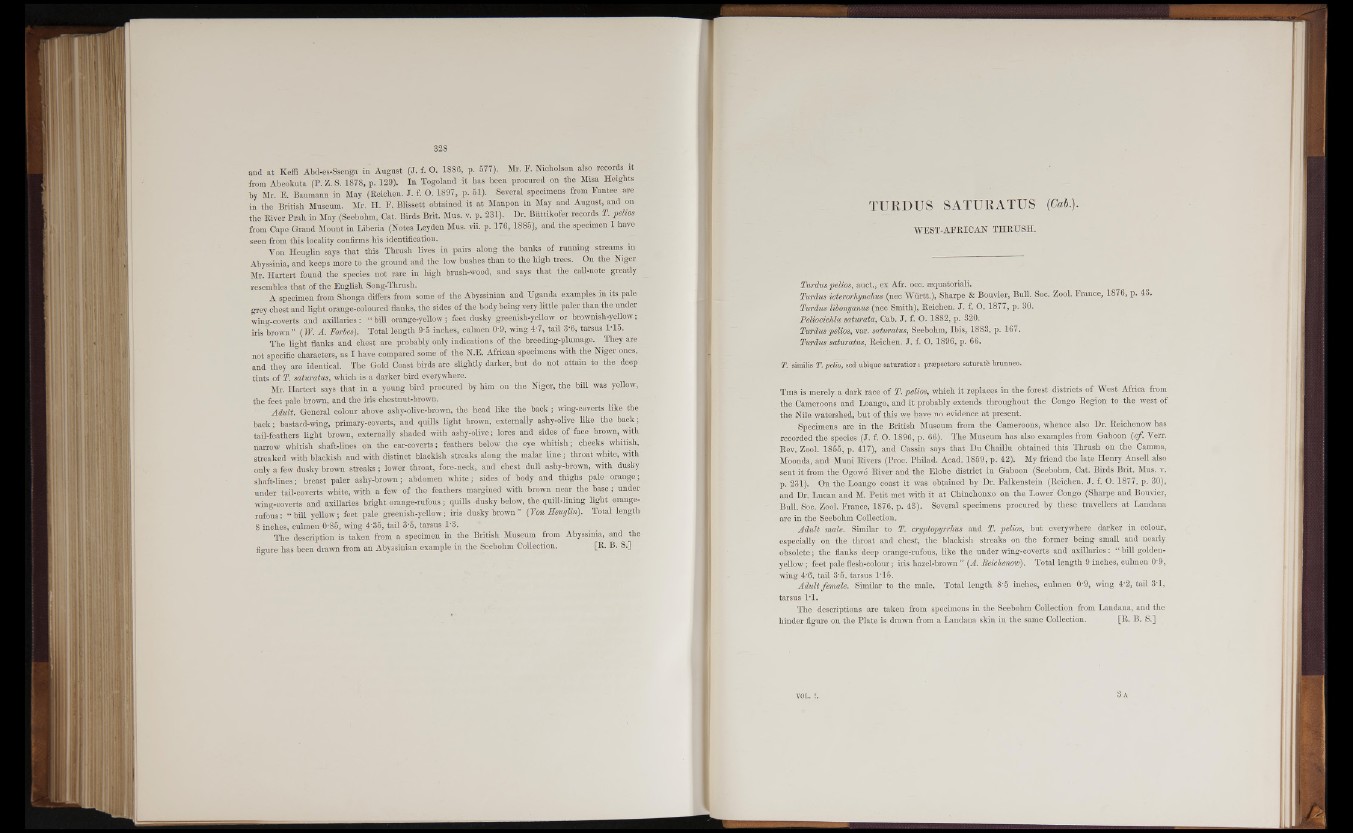
and at Keffi Abd-es-Ssenga in August (L f. O. 1886, p. 577). Mr. F. Nicholson also records it
from Abeokuta (P. Z. S. 1878, p. 129). In Togoland it bas been procured on the Misa Heights
by Mr. E. Baumann in May (Reichen. J. f. O. 1897, p. 51). Several specimens from Fantee are
in the British Museum. Mr. H. F. Blissett obtained it at Manpon in May and August, and on
the River Prah in May (Seebohm, Cat. Birds Brit. Mus. v. p. 231). Dr. Buttikofer records T. pelios
from Cape Grand Mount in Liberia (Notes Leyden Mus. vii. p. 176, 1885), and the specimen I have
seen from this locality confirms his‘identification.
Von Heuglin says that this Thrush lives in pairs along the banks of running streams m
Abyssinia, and keeps more to the ground and the low bushes than to the high trees. On the Niger
Mr. Hartert found the species not rare in high brush-wood, and says that the eall-note greatly
resembles that of the English Song-Thrush.
A specimen from Shonga differs from some of the Abyssinian and Uganda examples in its pale
grey chest and light orange-coloured flanks, the sides of the body being very little paler than the under
wing-coverts and axillaries : “ bill orange-yellow; feet duskygreenish-yellow or brownish-yellow;
iris brown” (W. A. Fortes). Total length 9'5 inches, culmen 0'9, wing 4'7, tail 3'6, tarsus 1T5.
The light flank» and chest are probably only indications of the breeding-plumage. They are
not specific characters, as I have compared some of the N.E. African specimens with the Niger ones,
and they are identical. The Gold Coast birds are slightly darker, but do not attain to the deep
tints of T. saturatus, which is a darker bird everywhere.
Mr. Hartert says that in a young bird procured by him on the Niger, the bill was yellow,
the feet pale brown, and the iris chestnut-brown.
Adult. General colour above ashy-olive-brown, the head like the back ; wing-coverts like the
back; bastard-wing, primary-coverts, and quills light brown, externally ashy-olive like the back;
tail-feathers light brown, externally shaded with ashy-olive; lores and sides of face brown, with
narrow whitish shaft-lines on the ear-coverts; feathers below the eye whitish; cheeks whitish,
streaked with blackish and with distinct blackish streaks along the malar line'; throat white, with
only a few dusky brown streaks; lower throat, fore-neck, and chest dull ashy-bfown, with dusky
shaft-lines; breast paler ashy-brown; abdomen white; sides of body and thigbs pale - orange;
,,n,W tail-eoverts white, with a few of the feathers margined with brown near the base ; under
wing-coverts and axillaries bright orange-rufous; quills -dusky below, the quill-lining light orange-
rufous: “ bill yellow; feet pale greenish-yellow; iris dusky brown” (Von Heuglin). Total length
8 inches, culmen 0*85, wing 4‘35, tail 3*5, tarsus 1‘3.
The description is taken from a specimen in the British Museum from Abyssinia, and the
figure has been drawn from an Abyssinian example in the Seebohm Collection. [R. B. SrJ
TURDUS SATURATUS (Cab.).
WEST-AFRICAN THRUSH.
Turdus pelios, auct., ex Afr. occ. sequatoriali.
Turdus icterorhynchus (nee Wiirtt.), Sharpe & Bouvier, Bull. Soc. Zool. France, 1876, p. 48.
Turdus libonyanus (nec Smith), Reichen. J. f. 0 . 1877, p. 30.
Peliocichla saturata, Cab. J. f. O. 1882, p. 820.
Turdus pelios, var. saturatus, Seebohm, Ibis, 1883, p. 167.
Turdus saturatus, Reichen. J. f. 0 . 1896, p. 66.
T. similis T. pelio, sed ubique saturatior: prsepectore saturate brunneo.
T his is merely a dark race of T. pelios, which it replaces in the forest districts of West Africa from
the Cameroons and Loango, and it probably extends throughout the Congo Region to the west of
the Nile watershed, but of this we have no evidence at present.
Specimens are in the British Museum from the Cameroons, whence also Dr. Reichenow has
recorded the species (J. f. 0 . 1896, p. 66). The Museum has also examples from Gaboon (cf. Verr.
Rev. Zool. 1855, p. 417), and Cassin says that Du Chaillu obtained this Thrush on the Camma,
Moonda, and Muni Rivers (Proc. Philad. Acad. 1859, p. 42). My friend the late Henry Ansell also
sent it from the Ogowe River and the Elobe district in Gaboon (Seebohm, Cat. Birds Brit. Mus. v. ■
p. 231). On the Loango coast it was obtained by Dr. Falkenstein (Reichen. J. f. O. 1877, p. 30),
and Dr. Lucan and M. Petit met with it at Chinchonxo on the Lower Congo (Sharpe and Bouvier,
Bull. Soc. Zool. France, 1876, p. 43). Several specimens procured by these travellers at Landana
are in the Seebohm Collection.
Adult male. Similar to T. cryptopyrrhus and T. pelios, but everywhere darker in colour,
especially on the throat and chest, the blackish streaks on the former being small and nearly
obsolete; the flanks deep orange-rufous, like the under wing-coverts and axillaries: “ bill golden-
yellow; feet pale flesh-colour; iris hazel-brown ” (A. Reichenow). Total length 9 inches, culmen 0*9,
wing 4-6, tail 3’5, tarsus 1T5.
Adult female. Similar to the male. Total length 8*5 inches, culmen 0*9, wing 4‘2, tail 3T,
tarsus 1*1.
The descriptions are taken from specimens in the Seebohm Collection from Landana, and the
hinder figure on the Plate is drawn from a Landana skin in the same Collection. [R. B. S.]
VOL. I.